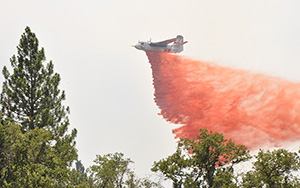
Dec. 12, 2017
When powerful Santa Ana winds pushed the Skirball Fire in Los Angeles toward homes in Bel Air and the Getty Center, one of the area’s iconic art museums, numerous aircraft were quickly deployed. Many were doing water drops, while others from the Los Angeles Police Department monitored the closed 405 Freeway, surrounded by electronic news gathering helicopters covering the intensifying blaze.
The FAA control tower at nearby Santa Monica Airport (SMO) provided visual separation for the busy airspace near the fire, allowing firefighters to limit damage to structures and save the priceless art collection inside the Getty Museum. The services provided by the SMO controllers are a critical resource that needs to be preserved, said Dave Hopkins, vice president of the Santa Monica Airport Association.
“With the fire being inside the FAA-protected airspace surrounding Santa Monica Airport, the key advantage was that the controllers could actually look out the window and make visual contact with all the aircraft working the incident,” he said. “The Santa Monica Airport and the controllers in its tower played a crucial role in fighting this particular fire.”
Hopkins pointed out that in the city of Santa Monica Office of Emergency Management All Hazards Mitigation Plan for 2015, SMO was listed as “critical infrastructure” vital to the continued delivery of key government services during an emergency.
“Without the airport, separation services in the area would be provided from FAA SoCal approach controllers, which are located in a windowless building in San Diego,” he said. “If the tower at Santa Monica was closed and a catastrophic event in the region caused the radar sites to go down or be degraded, the controllers at SoCal Approach would be trying to control aircraft blind. The obvious major advantage to having an FAA tower at Santa Monica is that they have visual contact with aircraft in their airspace.”
The Santa Monica Airport Association has an organization based at SMO called SMO DART, (Disaster Air Response Team) composed of pilots who volunteer their time and aircraft to support the American Red Cross.
“While the team was not used for the Skirball Fire, it was activated, with 10 aircraft and pilots available. Having disaster response available at Santa Monica Airport provides critical infrastructure for the community,” Hopkins said.
Earlier this year, the FAA and the city announced an agreement in which the city would only be required to keep the historic airfield open through Dec. 31, 2028, and would be authorized to reduce the length of SMO’s sole runway to 3,500 feet. NBAA and other stakeholders are challenging that agreement in court.
Learn more about the Santa Monica Aviation Airport Association.
